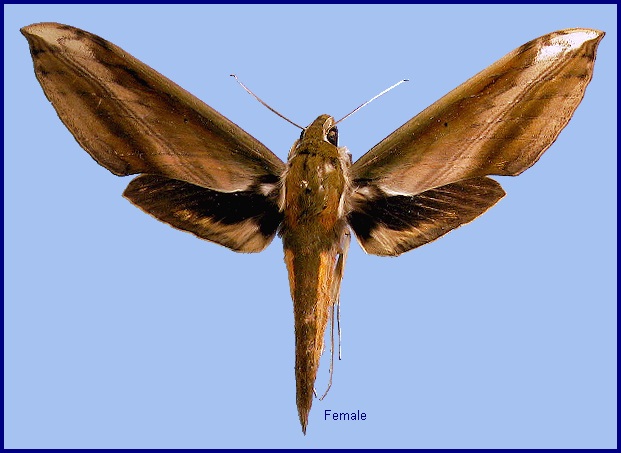
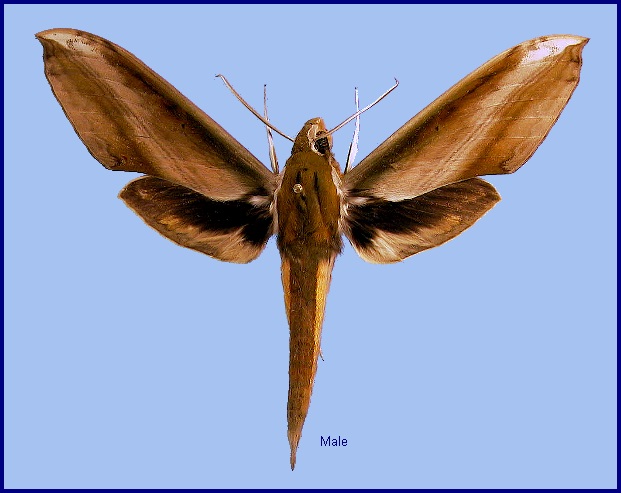
Sphinx nessus Drury, 1773, Illust. nat. Hist. exot. Insects 2: index [91]. Type locality: [India, Tamil Nadu,] Madras [Chennai].
Synonym. Sphinx nessus Drury, 1773.
Synonym. Sphinx equestris Fabricius, 1793.
Synonym. Chaerocampa nessus rubicundus (Schaufuss, 1870).
[Further details on this species in Japan, as well as photos of many stages, can be found on Digital Moths of Japan as well as Moths of the southern Shikoku, Japan.]
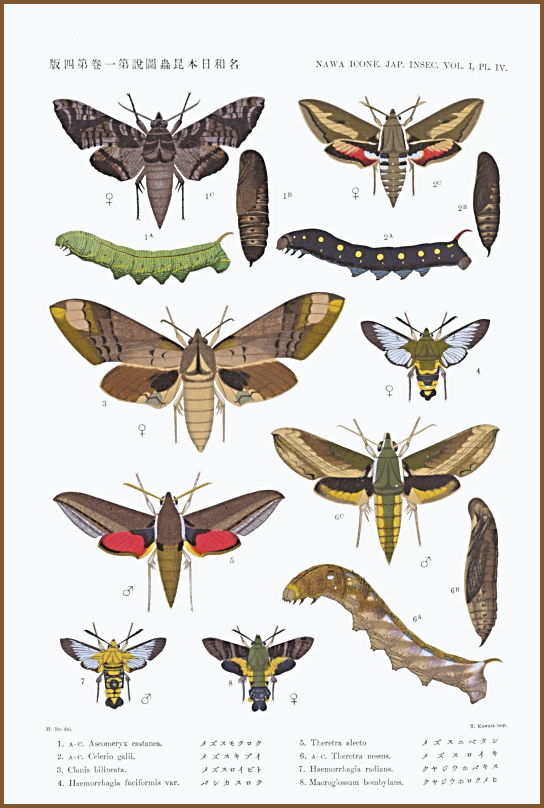
Wingspan: 90--130mm. An unmistakable species, characterized by the green band along the costal margin of the forewing upperside (which fades in museum specimens), the falcate apex of the forewing and the pair of broad, deep golden lateral stripes on the abdomen. Head and thorax olive-green, thorax suffused with ferruginous; a grey lateral stripe from palpus to end of thorax. Labial palp segment two more triangular than in other Theretra species; opening between segments 1 and 2 large, with some single long scales protruding. Outer row of forebasitarsal spines doubled and tripled.
In the male genitalia, uncus sinuate. Gnathos slightly spatulate, rounded apically. Valve with about 20 large stridulatory scales. Harpe very stout, short, upcurved apically; upperside somewhat concave, outer-dorsal edge irregularly notched, elevated proximally into a broad, compressed tooth; apex acute in lateral view, obtuse in subproximal view. Phallus with an elongate, reniform, multidentate, apical lobe. In the female genitalia, edge of ostium bursae not obviously raised into a ridge.
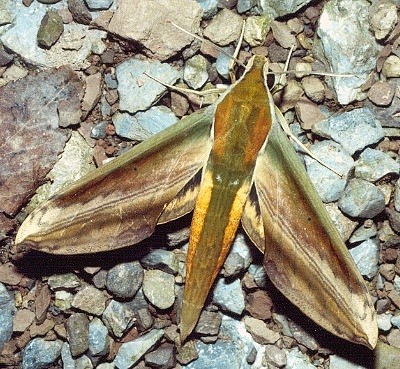
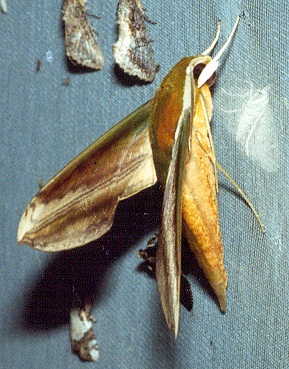
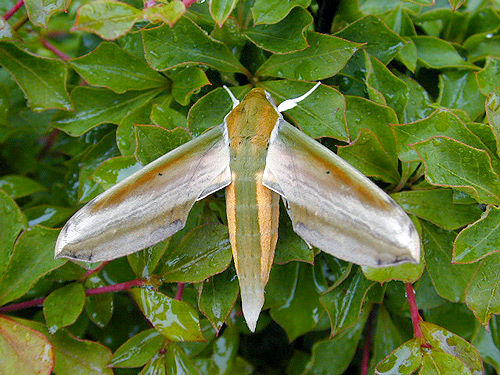
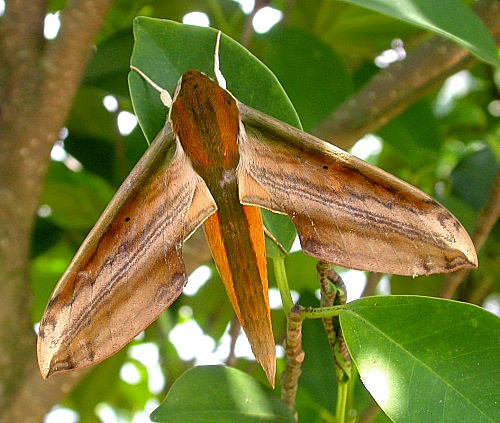
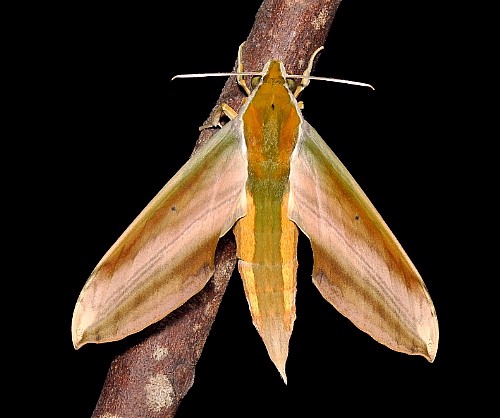
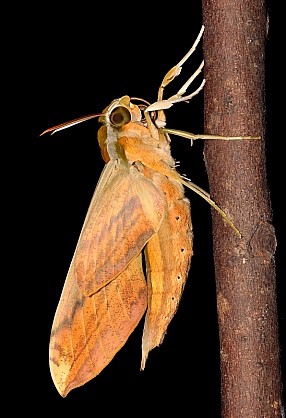
Attracted to the flowers of Plumeria rubra in Hong Kong, as well as coming readily to light (Tennent, 1992).
In Metro-Manila, the Philippines, this synanthropic species has been reported as being active at daybreak and during rainy weather, when it has been observed to drink from water puddles next to roads (Dvořák, 2014).
China: ii-xi (Hong Kong); 13.iii (Yunnan); 1-29.vi (Yunnan; Guizhou; Xizang/Tibet; Jiangxi; Hainan; Guangxi); 2-17.vii (Xizang/Tibet); 25-30.vii (Yunnan); ix (Guangdong); xi (Hainan). Taiwan: iii-iv (Kaohsiung Hsien); iv-x (Hualien Hsien); vii (Pingtung Hsien). Japan: 31.v (Shikoku); 22.vi-17.viii (Honshu); vii-viii (Kyushu; Ryukyu Archipelago); ix (Ryukyu Archipelago).
Kendrick (2002) states that T. nessus is multivoltine in Hong Kong, occurring from February until November, with peaks in mid April, and from mid September to early October.
Park et al. (1999) give early July until mid September as the flight period in South Korea.
OVUM:
LARVA: Full-fed 90--120mm, width 15mm, horn 10mm. According to Bell & Scott (1937), in the final instar, head small; clypeus triangular, slightly longer than broad, one-half length of head, apex minutely rounded; apex of false clypeus acute and reaching to a little more than one-half the length of head; labrum one-half length of clypeus; ligula semicircular in outline; cutting-edge of mandible strongly toothed. Surface of head dull and smooth. Body very stoutly built, segment 5 hardly swollen, horn of medium length, stout at base, tapering evenly to a sharp point, gently down-curved.
Colour variable. In the green form, head glaucous-green; labrum greenish, ligula yellowish; basal segment of antenna green, other segments rusty; mandible yellowish, tip dark reddish-brown; eyes brown. Body glaucous-green with a double whitish dorsal stripe from segment 4 to base of horn. Segments 4 to 12 blotched whitish dorsally and laterally. With a small, white, dorso-lateral, obliquely oval eye-spot on 5, and a still smaller one on 6, both edged narrowly with dark green, the long axes parallel with the oblique stripes. There are white oblique lateral stripes on 5 to 11, running up and back to the dorsal stripe, that on 11 running to base of horn. Horn bright yellow, brownish dorsally; legs yellow. Spiracles small, oval, white with a broad glaucous-green band across the middle (Bell & Scott, 1937).
In another form of the larva the head is pale brown; body ochreous on the dorsum, with short blue lines around the secondary rings and a large blue subdorsal patch on the front half of segments 6 to 11. There is a narrow brown dorsal stripe; a narrow brown dorso-lateral stripe from 3 to base of horn, edged below with white, narrowly on 3 to 5, broadly to base of horn; six or seven brown oblique stripes. The area below the dorso-lateral stripe pale brown with a number of short brown lines across the secondary rings. The eye-spot on segment 5 pale blue above, yellow below, that on 6 white. Spiracles with a instead of a green band (Bell & Scott, 1937).
In some individuals the dorsum is reddish-ochreous mottled with brown.
The larva is sluggish in its movements, moving slowly and jerkily, but feeds voraciously. It turns pinkish in colour before pupation, which sometimes takes place in a cocoon made among the leaves of the hostplant (Bell & Scott, 1937).
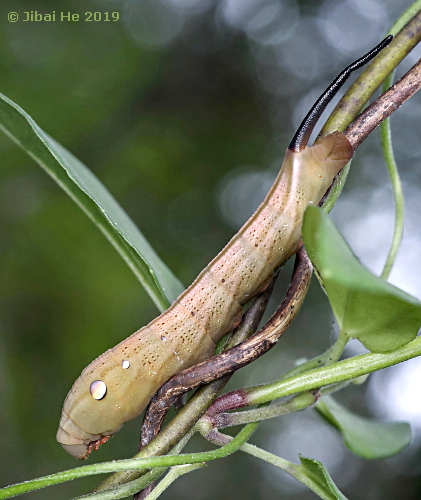
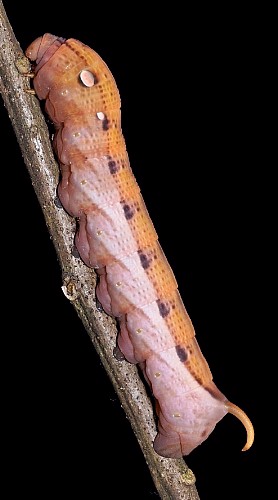
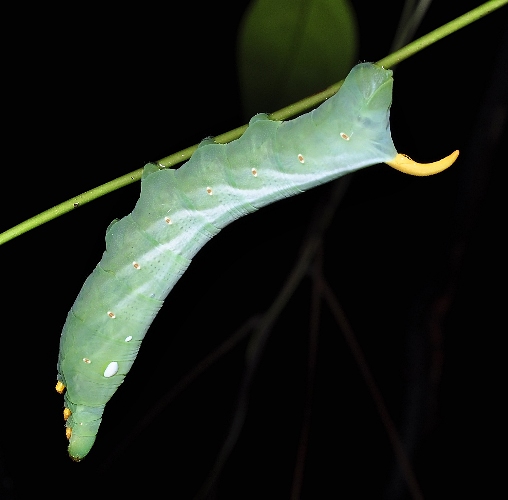
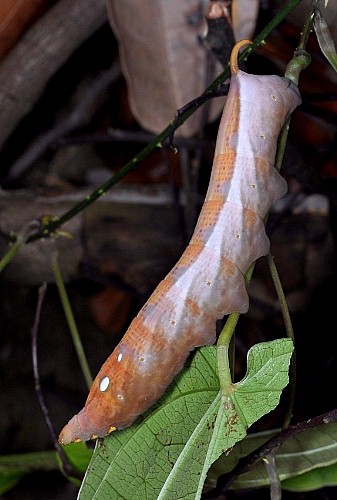
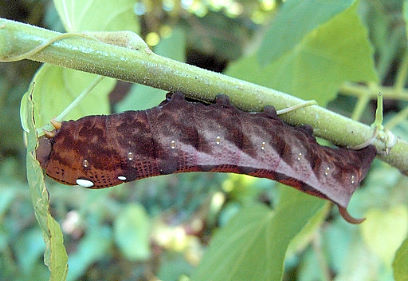
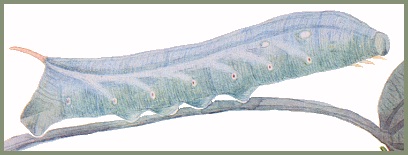
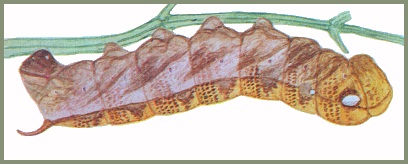
PUPA: 50--73mm, width 15mm. Head, thorax and wing-case ochreous mottled with fuscous; tongue-case dark brown; a pink patch below the eye. The abdomen is ochreous dorsally, rest dirty white suffused with fuscous and marked with short dark lines, except the venter and an irregular patch round each spiracle, these being dirty white; spiracles and a patch round each of those on segments 6 to 8 black, the white patches mentioned above surrounding the black patches; cremaster black except the ventral hollow, which is reddish (Bell & Scott, 1937).
Tongue-sheath projecting 5mm in front of head, the projection semicircular in side-view, ridged along its edge. Antenna shorter than fore leg, which reaches to between one-third and one-half distance to tip of wing-case, mid-leg to between one-half and two-thirds. Surface dull and smooth. Spiracle of 2 a narrow slit, the hind margin of 2 slightly curved-emarginate and the edge raised in front of it, a transversely oblong lobe, its surface slightly tilted upwards frontad, behind it; remaining spiracles oval, central slit with raised edges. Cremaster large, triangular, ending in a Y-shaped bifid shaft, or in two shafts close together and parallel with each other, each shaft bent outwards near its tip; upper surface convex, lower surface slightly hollowed, the basal half with a narrow mesial channel, distal half with a double mesial ridge, the whole longitudinally rugose (Bell & Scott, 1937).


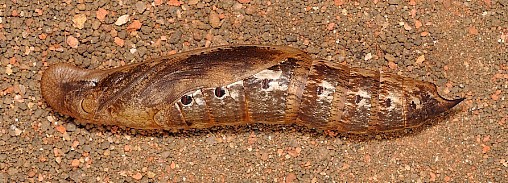
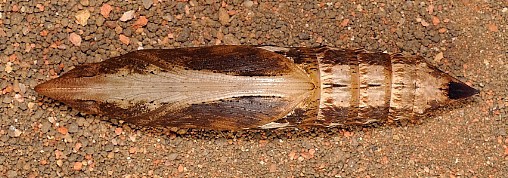
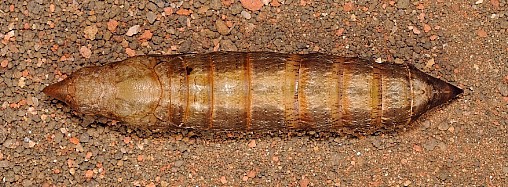
Larval hostplants. Many from many genera and families, including Amaranthus, Barringtonia, Dioscorea, Amorphophallus, Impatiens, Citrullus, Arathis, Boerhavia, Knoxia, Morinda, Oldenlandia, Pongamia, Spermacoce, Glossostigma and Camellia.
In Metro-Manila, the Philippines, larvae have been found on Dioscorea esculenta, Dioscorea alata, Dioscorea bulbifera and various species of Cayratia (Dvořák, 2014).
Tachinidae: Drino (Zygobothria) atropivora (Robineau-Desvoidy, 1830).
China: Hubei (Lichuan); Yunnan (nr. Yingjiang, Xima, 2080m; Mengla County, Mt. Leigongyan, 2000m; Gaoligong Shan; Simao/Pu'er; Malipo County, Wenshan Zhuang and Miao Autonomous Prefecture, 1860m); Xizang/Tibet (Zhangmu, 2200m; Yadong, 2900m; Gamtog; Xiachayu, Zayu County); Guizhou (Fanjingshan, Tongren County; Xinzhaidashan, Zhijin County, 1000-2000m); Hunan (Dayong; Mangshanxiang); Jiangxi (Le'an); Fujian; Guangdong (Longtou Shan; Wanzishan, Deqing; Guangzhou; Nanling National Forest Park); Macau; Hong Kong (Kowloon); Guangxi (Longtan National Forest Park, nr Guiping); Hainan (Sanya, Mt. Jianfengling; Duowen Ling, nr Lingao; Longhushan, Wenchang City).
Taiwan: Hualien Hsien (Taroko National Park); Kaohsiung Hsien (Shanping, 640m); Taipei Hsien (Fushan; Neihu; Wulai); Nantou Hsien (Lushan Spa); Pingtung Hsien (Kenting); Chiayi Hsien (Alishan); Taichung Hsien (Kukuan); Hualien Hsien (Antung; Hungyeh); Orchid Island/Botel Tobago.
South Korea: South Cholla Province (Yeon-do; Yeocheon); South Kyongsang Province (Goseong; Namhae); Cheju Province (Chuja-do; Seoguipo; Cheju-do; Topyung; Gonipdong; Hare-ri).
Japan: Honshu (Tokyo; Tokei-ji; Yokohama; Gifu; Kugenuma; Nashimoto; Fujisawa; Gozaishodake; Oki Islands (Kadowaki & Kishida, 1977)); Shikoku (Usa); Kyushu (Naze; Nishinakama); Tsushima; Tanegashima; Ryukyu Archipelago (Amamioshima; Kikaigashima; Okinawa; Tokunoshima; Iriomote-jima); Ogasawara/Bonin Islands.
Sri Lanka, India (including the Andaman and Nicobar Islands (Kailash Chandra & Rajan, 2004; Pathania, Sunita Sharma & Gill, 2014; Chakraborty, Chakraborty, Biswas, Chakraborty & Deb, 2024)), Nepal, Sikkim (Khan & Raina, 2017), Bhutan (Irungbam & Irungbam, 2019), Burma/Myanmar, Thailand, Vietnam (Le & Vu, 2024), southern China, Taiwan, South Korea, Japan, Malaysia, Singapore (Leong, 2011a; Leong, 2011b), Indonesia, northern Australia and New Caledonia (Common, 1990). Also Hawaii (1974 - Oahu (Riotte, 1977; 1986)) and Fiji as a recent immigrant (Clayton, 1995), as well as the Ogasawara/Bonin Islands (Takeuchi & Ohbayashi, 2006) farther north.
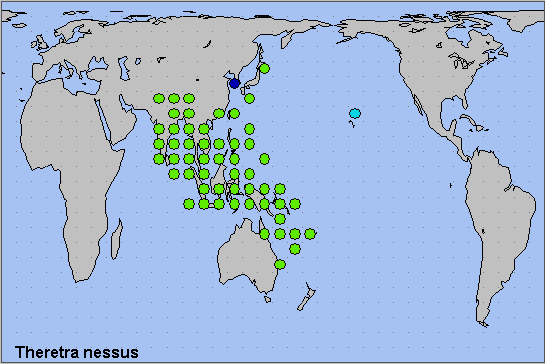
 Return to Sphingidae of the Eastern Palaearctic species list
Return to Sphingidae of the Eastern Palaearctic species list